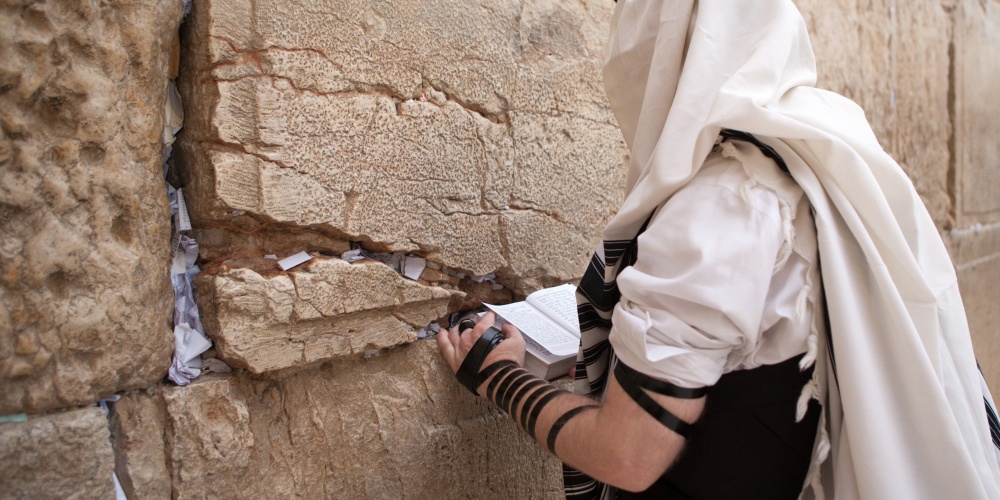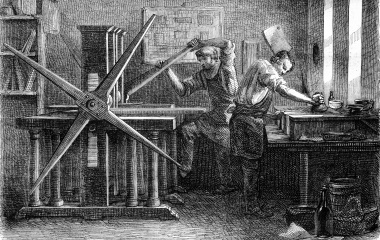
It is hard to imagine Jewish life without davening or brachot. They are amongst the most important of our religious practices. One of the ways COVID-19 has upended our lives is the impact it has had on our davening schedule, location, and intensity. It is all just so different.
Brachot, acknowledging our blessings—both in the physical world through birchot hanehenim, blessings made before partaking of food, and in the spiritual world through birchat hamitzvot, blessings made upon the performance of a mitzvah (between man and G-d)—is perhaps the most basic and necessary of religious obligations.
Perhaps even harder to imagine is Shabbat without kiddush or havdalah. Many who may not daven regularly (or at all) nor recite brachot do, thankfully, recite kiddush before a Friday night family meal.
Yet until the Second Temple period, some 1,000 years after the Torah was given, we had neither davening[1] nor brachot, and neither kiddush nor havdalah. “The Anshei Knesset haGedolah, Men of the Great Assembly instituted for Israel blessings and prayers, kiddush and havdalah” (Brachot 33a). It is the mostly anonymous members of the Anshei Knesset haGedolah who set the patterns of religious life that we still observe today. This, at a crucial point in Jewish history.
The Jewish people had been exiled from the land in 586 BCE, and while Cyrus the Great allowed them to return some 50 years later, very few actually did. Intermarriage and assimilation were all too common and, within a few short years, very few spoke Hebrew. Those who returned were from the lower socioeconomic classes; many also had questionable Jewish status. Yet the Anshei Knesset haGedolah managed to revive Jewish life and usher in the flourishing of Rabbinic Judaism. Is it any wonder they are known as the Anshei Knesset haGedolah, the Men of the Great Assembly? The Talmud explains that they are called Anshei Knesset haGedolah because “they returned the crown to its former glory” (Yoma 69b).
Yet the Gemara connects their name not to their establishment of prayer, brachot, kiddush, and havdalah but rather to their describing G-d in the same manner that Moshe Rabbeinu had in the Torah. “For the Lord your G-d is G-d supreme and Lord supreme, הַגָּדֹ֤ל הַגִּבֹּר֙ וְהַנּוֹרָ֔א, the great, the mighty, and the awesome G-d” (Devarim 10:17).
Yet history had demonstrated otherwise. “Yirmiyahu came and said: ‘Gentiles are carousing in His sanctuary; where is His awesomeness?’ He did not say norah, awesome. Daniel came and said: ‘Gentiles are enslaving His children; where is His might?’ He did not say gibor, mighty”. While not disagreeing with the assessments of Yirmiyahu and Daniel, the Anshei Knesset HagGedolah argued, “Adaraba, on the contrary, this is His strength: He conquers His inclination[2], He exercises patience toward the wicked. And this is His awesomeness: Were it not for the awesomeness of the Holy One, Blessed be He, how could one people survive among the nations?” (Yoma 69b).
The greatness of the Anshei Knesset haGedolah was manifest in their ability to see the potential for greatness despite destruction, to build for the future despite the horrors of the past. Living in the aftermath of the destruction of the Temple and exile, the Jewish people could have given up hope, could have stopped dreaming of a return to the land. And when only 42,000 people did return when given the opportunity to do so, one might have argued what the point was of rebuilding? Perhaps the time had come to assimilate amongst the nations, like so many others.
Instead, the Anshei Knesset haGedolah forged ahead, seeing the survival of the Jewish people as no less than a miracle and hence, of historical importance. It was time to lay the groundwork for the revival of the Jewish people and lead them to a glorious future. They established the Shemonah Esrei as our fundamental prayer, beginning it with the words of Moshe, “haE-l haGadol v’haNorah, the great, the mighty, and the awesome”, words that Yirmiyahu and Daniel could not say.
What the Anshei Knesset haGedolah did was wonderful, but how could Yirmiyahu and Daniel alter the description of G-d? It is the Torah itself that describes G-d as haE-l haGadol v’haNorah. How, then, did they have the chutzpah to remove that which is written in the Torah? How could they tamper with the Divine text?
Yet instead of criticizing them, the Gemara notes—or perhaps even praises them for—their dedication to truth. “They knew of the Holy One, Blessed be He, that He is truthful. Consequently, they did not speak falsely about Him[3]”. Witnessing destruction, desolation, suffering and death, Yirmiyahu and Daniel could not describe G-d as haE-l haGadol v’haNorah. The Torah can say what it wants, but hachush machish[4], their own eyes and experiences showed otherwise. The awesomeness and might of G-d was nowhere to be seen.
While these words explain the naming of the Anshei Knesset haGedolah over 2,500 years ago, they could just as easily been describing Jewish history of the 20th century. The Jewish people suffered more than anything that Yirmiyahu and Daniel may have witnessed. Our enemies tried—and tragically, had much “success” — to destroy us. Not only did our “friends” do next to nothing to help, G-d, too, was nowhere to be found, even as His chosen nation was nearly wiped out. Many could no longer “believe” in G-d; to do so would ascribe too much evil to Him. Not only could one not say haE-l and haGibor to describe G-d, many could not even talk to Him anymore. Yet…
Three years later, a renewed Jewish state arose, the greatest kiddush Hashem in thousands of years, following the greatest chilul Hashem[5]. Fully cognizant of the historic significance of the moment, the founders of the reborn State of Israel named their parliament the Knesset. Furthermore, this new Knesset was to have 120 members, just like the Anshei Knesset haGedolah. We could once again say, haE-l haGadol vehaNorah. The glory of G-d and the Jewish people once again could return[6].
And with the return to Zion and eventually Jerusalem, with myriads filling the streets, there is Baruch Hashem, another “untruth” that many can no longer say. “The city that is in mourning and in ruins, despised and desolate. Mourning because she is bereft of her children, ruined of her dwellings, despised in contrast to her former glory, desolate without inhabitants, she sits alone with her head covered like a barren woman who never gave birth”.
We today have merited to see “A city built up, beloved and populous. Joyous with so many children, beautified by her buildings, rivaling her former glory, full of inhabitants, she joins with so many like a fertile mother who has raised so many children”.
As we prepare for the period of the three weeks, let us pray that the redemptive process will gather steam and we will have good reason to replace the words of nachem with a blessing of thanksgiving for the full redemption, one that ensures the greatness of G-d will be evident to all.
[1] It is possible that some form of prayer existed prior; yet even if so, it was very, very different, with no Amidah and no fixed schedule of three times a day.
[2] This definition of strength is familiar to us from the teaching of Ben Zoma in Pirkei Avot (4:1).
[3] It is surely no coincidence that, just a few lines prior, the Gemara notes that chotamo shel Hakadosh Baruch Hu emet, the signature of G-d is truth.
[4] This is the expression used by the Vilna Gaon in arguing that the position of the Tosafists that the day extends some 55 minutes after sunset is wrong. One can bring all the Talmudic proofs one wants, but all one has to do to disprove them is go outside, say, 50 minutes after sunset and note that it is pitch black (even more so in 18th century Lithuania).
[5] See chapter 36 of sefer Yechezkel for the connection between exile and chilul Hashem and redemption and kiddush Hashem.
[6] For an elaboration of how the State of Israel restored the glory of G-d and the Jewish people, see (and read) Rav Soloveitchik’s classic essay, “Kol Dodi Dofek”.



